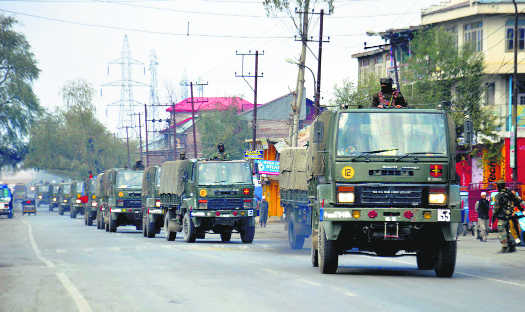
An Army convoy in the Valley. Tribune file Photo
Majid Jahangir
Tribune News Service
Srinagar, November 26
Last week thousands of Kashmiri youth participated at an Army recruitment rally at Panzgam garrison in frontier Kupwara district to don the olive green. In July, more than 3,000 youth from J&K took the written exam for the selection of officers in the Territorial Army.In April, Farooq Dar, a shawl weaver, was tied to a jeep and used as a “human shield” by a Major for allegedly escaping stone throwers during the parliamentary bypoll in Budgam. The officer was later awarded the Chief of Army Staff Commendation (COAS). The human shield incident had sparked outrage in the region, deepening the army-civilian divide.These two examples explain the two narratives about the Army in Kashmir which is at the forefront in counter-insurgency and counter-infiltration operations in Kashmir since the outbreak of militancy. The past baggage of the alleged mass rape in Kunanpospora, Kupwara, in 1991 and a series of fake encounters like Pathribal, Machil and ‘enforced disappearances’ have dealt a major blow to the Army’s image. The Army, however, has always denied the allegations of mass rape in Kunanpospora.Over the years, however, the complaints of human rights violations against the Army in Kashmir have considerably reduced as the force has focused on image-building in the Valley.To win the hearts of people, the Army in 1998 started Sadbhavana — a goodwill programme — with an objective to bridge the gap between the ‘jawaan’ (Army) and ‘awaam’ (people). At present over 500 projects of Sadbhavana are underway in various developmental sectors across Kashmir.However, over the years the Army has been successful in bridging the gap only to some extent. In Kupwara, for example, the Army has maintained good relations with people for over a decade but the district witnessed hundreds of stone-throwing incidents during the 2016 unrest.“It is wrong to interpret that Sadbhavana will have an impact on the political situation of Kashmir. Kupwara has the highest military concentration, but when there is a political problem, it also behaves like the rest of the Valley,” said Mohammad Adil, 32, a businessman from Kupwara town.A postgraduate student from Srinagar, Shabnum Kulsum said the Army was “meant for security but their image is negative among youth for killings and creating an atmosphere of fear”.“No matter how many publicity programmes the Army tries to organise in Kashmir, its image will always scare a Kashmiri,” Kulsum said.Political scientist Noor Ahmad Baba said relations between people and the Army are never good in a conflict situation. “Naturally when the Army is in contact with people, especially in a conflict situation, relation are not always good,” he said.However, the surrender of footballer-turned-Lashkar-e-Toiba militant Majid Khan tells a different story of the ties between the Army and people in south Kashmir.“When young Majid Khan decided to return, the Army was contacted and not any other security agency. This shows the level of trust the Army has been able to gain from the people. “Even when one militant was injured in a gunfight where we lost a soldier, we accepted his surrender. It shows the humane face of the Army and the trust it enjoys here,” said an Army officer in Kashmir. “However, there are always elements in some pockets who want to create issues and widen the gap between the locals and the Army. A majority of the people supports us, but due to fear they don’t want to say it in public. We are enjoying excellent relations with the people.”In the early 1990s, when militancy was at its peak, few Kashmiri youth used to join the Army. The trend, however, changed slowly after the Army started holding massive recruitment rallies. Over 5,000 Kashmiris are serving in the Army at present and there are nearly 8,500 ex-servicemen. At least seven Kashmiri Army men, including the unarmed Lt Ummer Fayaz, have been killed in Kashmir.The continuation of AFSPA is another issue with the people. “The Army recently said around 200 militants were active in the Valley. How does the government justify such a large presence of the Army now and AFSPA?” asked Khursheed Ahmed, a Srinagar resident. The Army, however, has been maintaining that time is not ripe for the withdrawal of the Armed Forces Special Powers Act.
Bridging the gap
Over the years the Army has been successful in bridging the gap only to some extent. In Kupwara, for example, the Army has maintained good relations with people for over a decade but the district witnessed hundreds of stone-throwing incidents during the 2016 unrest.
